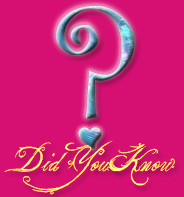Did You Know? Facts, Figures & Folklore About Valentine’s Day
Did you know that Valentine’s Day is named for not one, but many, martyred saints named Valentine or Valentinus, all of whom are believed  to have been martyred on February 14th?
to have been martyred on February 14th?
The name Valentine is derived from a Latin word meaning valor.
Did you know that, according to one legend, Valentine’s Day was inspired bySaint Valentine, a Roman saint who was executed on February 14th, 270 A.D.?
St. Valentine was killed for secretly marrying couples in defiance of an order of the Roman emperor. The emperor had forbidden marriage after Roman men began refusing conscription in order to stay home with their wives.
Did you know that Cupid, the winged child who pierced the hearts of his victims, causing them to fall in love, was known in Greek mythology as Eros, the son of Aphrodite, the goddess of love?
It was in Roman mythology that he was called Cupid, son of Venus. Cupid is now a mainstay of Valentine’s Day marketing campaigns, featured prominently on greeting cards and boxes of chocolates.
Did you know that people have sent verses to their loved ones on Valentine’s Day since as far back as the Middle Ages?
The oldest known Valentine’s Day greeting, which was sent in the 1400s, is currently housed in the British Museum. Today, Americans are prolific senders of Valentine’s Day greetings, sending more than 180 million Valentine’s cards by mail, and exchanging another 700 million at school or work.
Did you know that exchanging Valentine’s cards likely began in America as early as the 1700s?
The first mass-produced Valentine’s Day card was sold in the 1840s by Esther Howland, a Massachusetts native. She originally sold hand-made, lace cards for as much as $35 per card.
Did you know that the oldest known Valentine’s Day card is on display at a London museum?
The card was sent in 1415 by the Duke of Orleans to his wife in France. The Duke was imprisoned at the time in the Tower of London.
Did you know that 65 percent of American households send or exchange greeting cards?
More than 180 million Valentine’s cards are sent by mail, with another 700 million homemade and store-bought Valentine’s exchanged at school and work.
Did you know that Hallmark sells over 1,300 different styles of Valentine’s Day cards?
February 14th is the second most popular card-giving holiday. Christmas is the first most popular.
And as a side note – Each year Hallmark displays its collection of rare and antique valentines at card shops around the country.
Did you know that men spend an average of $156.22 on Valentine’s Day gifts, flowers and cards?
Women, by contrast, spend just $85.08. But if even $8 sounds like a budget buster to you, don’t worry: Romance doesn’t have to cost a fortune on Valentine’s Day. In fact, it doesn’t have to cost anything at all. Consider packing up a romantic picnic of leftovers and sparkling apple cider, or writing a heartfelt love poem. (Source: BIGresearch)
Did you know that 38 percent of Americans buy candy for their loved ones on Valentines Day?
The first heart-shaped box of candy was sold in 1868 by Richard Cadbury.
Did you know that chocolate has long been considered an aphrodisiac?
The Aztec emperor Montezuma drank ground cocoa beans to increase his sexual prowess. In Mesoamerican marriage ceremonies, the couple shared a ritual cup of cocoa, which was believed to increase their luck in love.
Did you know that chocolate has been sold commercially since at least the late 1600s?
That’s when chocolate emporiums began opening across Europe, serving up cocoa baked into cakes and eventually into candies. Then in the 1800s, famous British chocolatier Richard Cadbury upped the ante by selling chocolates in a heart-shaped box, giving birth to a Valentine’s Day cliché!
Did you know that 32 percent of Americans purchase flowers on Valentine’s Day?
Three-quarters of those who buy the flowers are men.
Did you know that the red rose was believed to be the favorite flower of Venus, the Roman goddess of love and the mother of Cupid?
Did you know that Americans buy and send more than 110 million roses for Valentine’s Day?
California is the leading domestic producer of roses, although the majority of the ones sold on Valentine’s Day are imported from South America.
Did you know that one in 10 Americans buy jewelry as a Valentine’s Day gift?
In 2005, February jewelry sales topped $2.4 billion.
Did you know that on Valentine’s Day, 1876, Alexander Graham Bell applied for a patent on his invention, the telephone, which he called “an improvement in telegraphy”?
If you can’t be with your loved one on Valentine’s Day, you can “reach out and touch someone” — thanks to Mr. Bell.
Did you know that the expression “wear your heart on your sleeve” comes from a Middle Ages Valentine’s Day tradition?
Young men and women would draw the name of their Valentine from a bowl. They would wear their selected name on their sleeves for one week.
Did you know that Valentine’s Day was first declared an official holiday by King Henry VIII of England in 1537?
Today Valentine’s Day is celebrated on February 14th in the United Kingdom, the United States, Canada, Mexico, France and Australia.
Did you know that Valentine’s Day is celebrated in countries around the world, including Korea?
There, women are the traditional gift bearers on February 14th. But a month later, on March 14th, men return the generosity. The holiday, known as White Day, is so named since the traditional gift is “white chocolate”. In a nod to Korean singles, April 14th is referred to tongue-in-cheek as Black Day, when singles get together with friends and eat black-colored Jajang noodles.
Did you know that in Colombia, Valentines Day is celebrated in September?
And Brazil, Valentine’s Day, otherwise known as the Day of the Enamored, is on June 12. In Israel, Tu B’Av is the holiday of love, celebrated in late summer.



